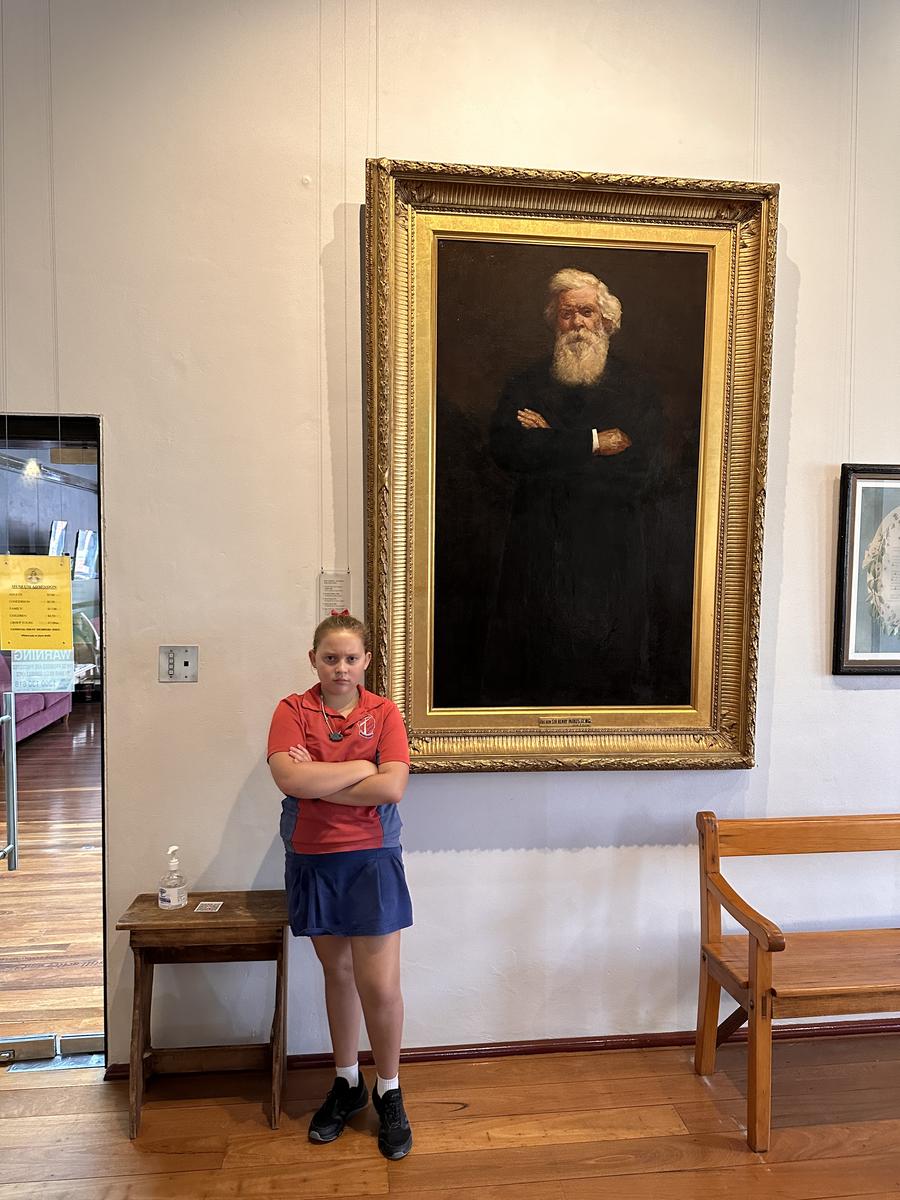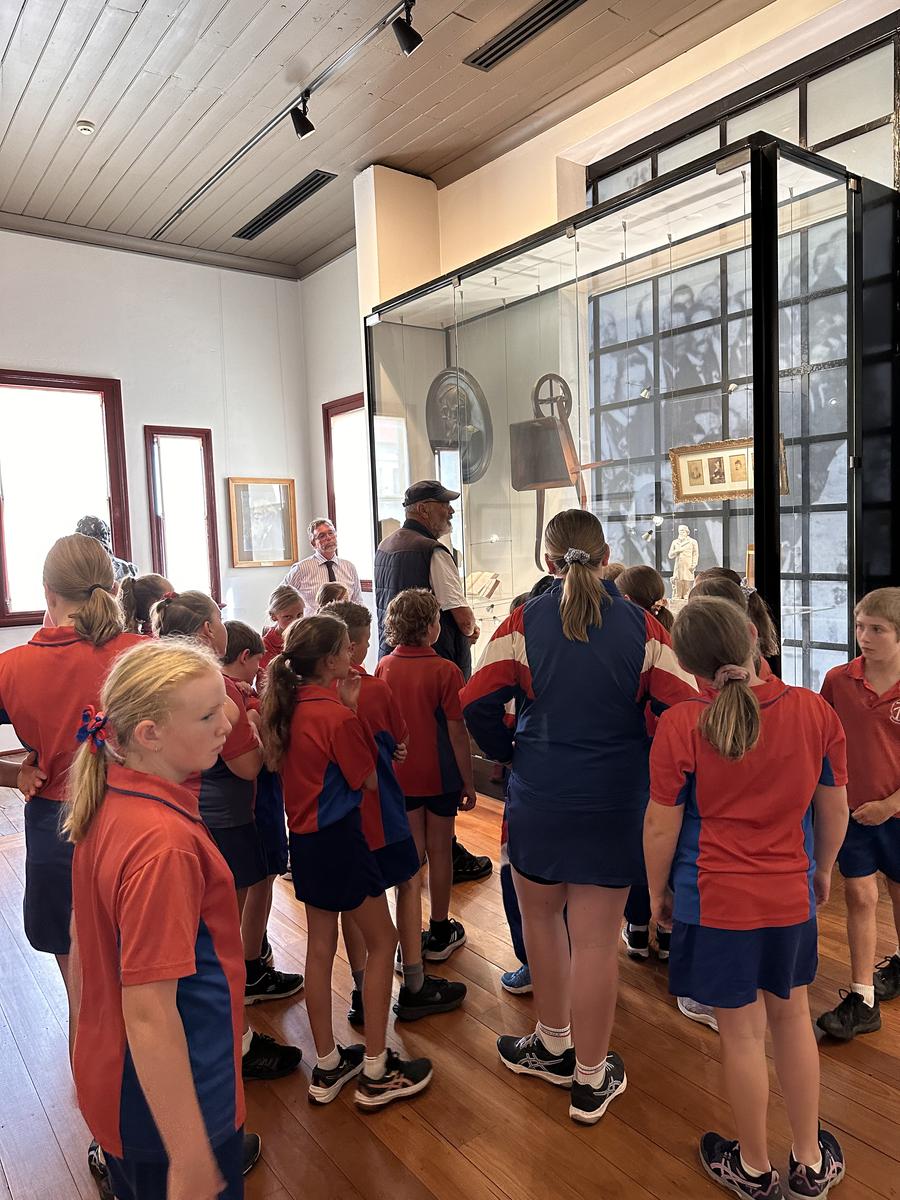Stage 3 visit to Tenterfield

STAGE 3 EXCURSION TO TENTERFIELD-
WRITTEN BY THE STUDENTS OF STAGE 3
On the 27th March, Stage 3 went on an adventure to Tenterfield. In class we have been learning about the history of Australia, in particular, Federation. As Tenterfield is the BirthPlace of Our Nation and where Sir Henry Parkes made his famous Oration speech for Federation, it was the perfect destination. We went to the Railway Museum, The School of Arts and Centenary Cottage. We would like to thank Mr McManus, Mrs Fletcher for coming with us and our teachers for organising the excursion.
Railway Museum:
Walking through the very famous door that even Sir Henry Parks and King George walked through, we entered the historical Railway Museum. It was a shock to all of us after we heard this news! As we tried to peek through the doors of several old rooms, we were sorted into groups to get a tour around this remarkable place.
In the rooms there were old typewriters, pictures of soldiers, guns and even a miniature railway scene! This was really cool, however, we all wanted to get outside and onto the trains.
The first place our group visited was the barracks, where train conductors would sleep on their stopovers. Back then they had a bed, bookshelf, table and a chair plus a journal or a book. One person would sleep in the room and if they had to go to the bathroom they would have to walk outside in freezing cold weather to go to the toilet, talk about annoying! Feeling hungry? Don't worry the butler (aka a woman back then) will grab you a 5 star meal, also known as stale bread and tea!
After we went to the Barracks we finally got to go and see the trains. There were many different types of trains, including the travelling train, steam, diesel, cattle and sheep, water tanker and compartments which transported small animals and coffins! We learnt a lot about the different trains and many things of interest were pointed out to us, including the rear mirror that helped the train conductor see behind him and the fact that trains didn’t actually have a steering wheel, it was put in for young children to enjoy! We were allowed to sit in the seats with tables with fancy cutlery, pretend to drive the train, change the direction of the tracks by pulling the switch levers and sit on and in all the old versions of trikes that were used on the railway.
SCHOOL OF ARTS
At 11:00am, we made our second stop at The School of Arts building. We walked through the nicely decorated door with golden handles, and began the tour. The room was decked with glass cabinets, and large, important framed paintings. There was even a sculpture of Sir Henry Parkes (Australian Federation being the focus), and some of his creations. We were told that he was a very creative person, and loved to carve ivory, (that came from elephant tusks). There were news articles he wrote, paintings of Henry, and the canes he made.He also had 3 wives throughout his life! We wandered about the room for a little while observing the many wonders of Sir Henry Parkes -The Father of Federation.
To our surprise, there was more! Between the two cabinets, was an invisible-like door, it fit in perfectly with the wall which made it hardly noticeable. We pushed the door open to enter another room, this time a hall! Flags of Australia's states clothed the walls, and in the middle of the room, was a massive table. It was really long, quite wide, and the story behind it was amazing. Henry Parkes delivered his Federation speech (oration), at that table which led us to today, federated as one country. Later on, glass was added to the middle of the table, to hold and display artefacts, and objects linking to the speech. There were also cartoon pictures from the time with meanings behind them, and another room! The third room held objects from the First Nations peoples, and other cultures, such as spears, and stones.
After looking through the rooms again, we headed through to the cinemas to watch a film. It featured Henry Parkes, and had many facts about his life, including his wives’ names, ages, and how many children he had. Sir Henry Parkes , had 17 children, and his wives’ names were: Julia Lynch, Clarinda Varney, and Eleanor Dixon. He married all of them, as the first, then the second passed. Eleanor was 57 years younger than him! She then had to care for all the children when he died.
Overall, The School of Arts was an extraordinary place to visit, as we learned so much about Sir Henry Parkes, and amazed us with how much dedication he had to the Federation of Australia. Sadly, he didn’t live long enough to see his plan work.
Centenary Cottage
4 rotations, 4 amazing leaders and 4 glimpses into the past. We arrived at the Centenary Cottage after lunch and were tricked by its humble appearance. After going to our groups we began.
My group started in a small cottage beside the main house and was immediately startled by the mesh covered bed. The small cottage was made up of 4 rooms. Outside we were greeted with an old tricycle, some old washers and wringers and the old baby's cot. After going inside we were greeted with a small yet homely kitchen. We proceeded to the main parlor which had a piano and some old, worn chairs. Next we went into a bedroom which had the following: a toilet, a bathtub, 2 beds and finally some beautiful clothing.
We looked at amazing farming tools that were from back in the ancient times. Albert, one of our tour guides, described all about how they used tools by hand and showed how they ploughed and harvested by using horses. We looked at an old rusted steam train as well as some old tractors. We saw old horse saddles and bridles the farmers put on the horses. Around half way through we were shocked by a mighty crocodile skin. We also saw an old cordial maker.
On our 3rd station we saw old army photos, swords, saddles, guns and badges and they were all the real things that the young soldiers from WW1 and WW2 had held, wore or used in the olden days. Joyce, another tour guide, spoke and explained what they were used for or what year they were used in and the year that the soldiers passed away.
Centenary cottage itself had a kitchen that was detached from the house so the whole house wouldn’t catch on fire, only the kitchen. Looking around we saw ancient kitchen tools, different fridges, beds, piano, toilet, a working gramophone, fireplace and many more ancient historical items. Kay showed us how many things worked and how they used all of the furniture. We saw all of the old baby strollers and cots, the parents bed, closets, couches and tables.
We are sure that the class had the time of their life, even our teachers had a wonderful time looking at everything. We were so grateful that the guides took the time out of their busy days to show us around.



















